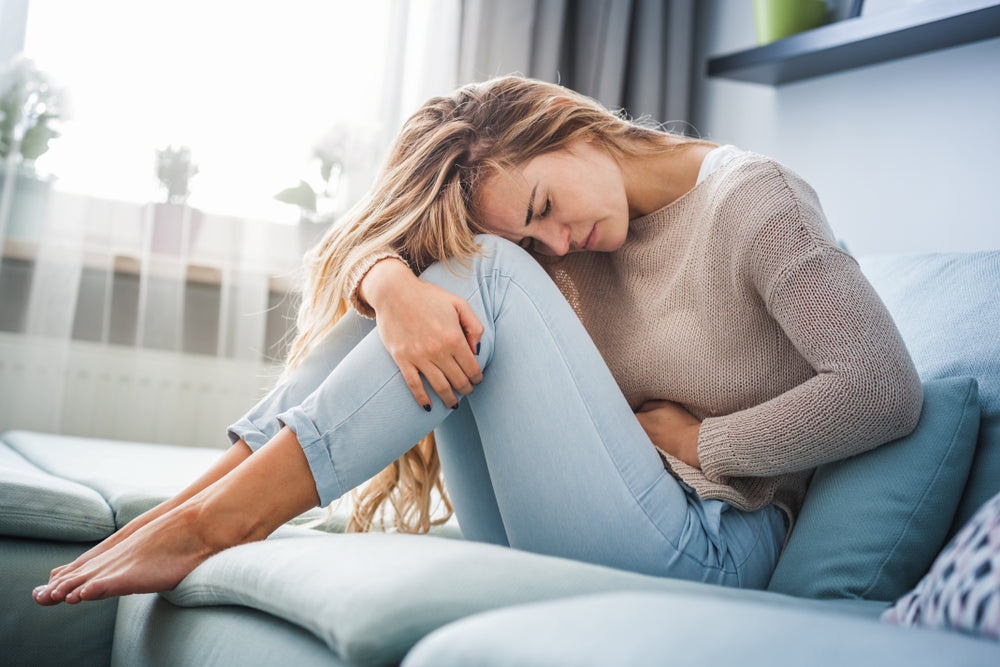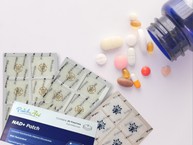Most women experience premenstrual syndrome, or PMS, to some degree, and it is more severe for some women. There are many simple ways you can relieve or prevent symptoms, including staying well nourished. The Easy Cycle Patch by PatchAid is a convenient choice, so ask your doctor if it may be right for you.*
Recognizing and Diagnosing PMS
The symptoms of PMS may appear about 10 days to 2 weeks before the onset of menstruation. During this time, hormone levels fluctuate the most. These changes may strain the body and lead to symptoms.
These are some common symptoms of PMS.
- Headaches
- Abdominal cramps, bloating, or other discomfort
- Constipation or diarrhea
- Irritability or mood swings
- Increase acne
- Anxiety
- Trouble concentrating
- Not feeling as social as usual
The symptoms are nonspecific, which means that other conditions can cause them, too. It’s best to talk to your doctor about any symptoms you are having to determine whether you have PMS or a condition such as thyroid disease. Your doctor can also help decide whether you need additional care.
8 Tips for Relieving PMS Symptoms
These tips can help you relieve or prevent PMS symptoms. You can practice them at any time during the month for better results.
1. Hydrate
Staying hydrated can help prevent headaches and fatigue related to dehydration. You also need to keep hydrated to prevent muscle cramping. Staying hydrated helps prevent or reduce bloating and water retention.
Choose water or other low-calorie beverages instead of sugar-sweetened drinks for best results. Since caffeine can make symptoms of PMS worse, it’s best to avoid caffeinated coffee and tea. Decaf coffee, decaf green or black tea, and herbal tea are alternatives. It’s also best to avoid alcohol, which can lead to dehydration.
2. Eat Cleanly
Clean eating can always make you feel better, but especially around that time of the month. Fruit, vegetables, and lean proteins, such as fish, beans, tofu, and egg whites, are usually safe choices. Healthy fats include peanut butter, avocados, olive oil, seeds, and nuts such as walnuts, hazelnuts, almonds, and pistachios.
You may notice effects of avoiding low-nutrient choices, such as processed meats, refined carbs like bagels, pasta, and white rice, and fried foods like French fries, fried chicken, and doughnuts.
3. Supplement Your Diet
Supplements can provide nutrients or herbal ingredients that you’re not getting from your diet. The Easy Cycle Patch by PatchAid has magnesium and calcium, which are necessary for muscles to relax properly instead of cramping. Maca root is a naturally nutrient-rich supplement used to improve mood, and chaste berry fruit extract has been used to normalize symptoms of your cycle. Black cohosh and evening primrose oil are other natural supplements that are taken for women’s health.*
It’s also noteworthy that the Easy Cycle Patch is convenient. You don’t have to swallow any oral supplements or worry about allergies to soy, dairy, or gluten. Just apply a patch to your skin and leave it on for up to 8 hours as the active ingredients are absorbed transdermally. Remove the patch and repeat the next day.
4. Be Active
Physical activity can help prevent or relieve symptoms of PMS, even though an old-fashioned belief was that it was harmful. Physical activity can help improve mood and energy levels. It can make your muscles feel better and even settle your stomach.
Maintaining your usual routine if you tend to be active is often a good idea. Or, you can listen to your body and cut back a bit if you like. Walking is a safe activity for most people, provided your healthcare provider agrees.
5. Rest
If you’re especially tired, try to rest. Extra sleep is never a bad idea if you’re feeling tired, and maybe you can sleep for longer at night or take a nap during the day.
Resting can also mean things other than getting more sleep. It may mean taking on fewer responsibilities at work or home if that’s possible. You might even consider asking for help on some days, or putting off tasks that may feel too hard when you have symptoms of PMS, but that will feel easier to complete once the symptoms have passed.
6. Make Yourself Comfortable
Something as simple as focusing on how you feel, and responding accordingly, can make a huge difference in symptoms of PMS and how you perceive them. A simple remedy is to use a heating pad if you are experiencing abdominal cramps. You can also experiment with comfortable cushions or a favorite blanket to make yourself feel better.
7. Take a Step Back
If you’re anxious, irritable, or dreading talking to people, it may be time to give yourself a bit of a time-out. Sometimes, retreating to a quiet or dark space can help. It reduces sensory input so you’re less likely to feel overwhelmed. Getting away from too many people, too much noise, or very bright lights can help prevent or relieve headaches, and it can be calming. Even a few minutes of respite when you’re feeling a sensory overload can help.
8. Ask About Over-the-Counter Medications
Sometimes, a headache, cramps, or other symptoms are too stubborn to go away with household remedies. If that’s the case, talk to your healthcare provider. She may suggest mild over-the-counter medications, such as NSAIDs or non-steroidal antiinflammatory drugs. These can include ibuprofen and advil, and may relieve pain and fevers.
While you can’t always entirely prevent or avoid symptoms of PMS, you can do a lot to relieve them. Lifestyle changes, household remedies, and even mild medications may help. The Easy Cycle Patch by PatchAid contains ingredients that have been used for centuries to relieve symptoms of PMS,* and it couldn’t be easier to use. Ask your healthcare provider before using any nutritional supplement, and talk to your doctor if you have any concerning or worsening symptoms of PMS.
*The Food and Drug Administration has not evaluated these statements. PatchAid patches are not intended to diagnose, treat, cure or prevent any disease. Anyone with a medical condition should seek the advice of a licensed medical practitioner. Individual results may vary.







